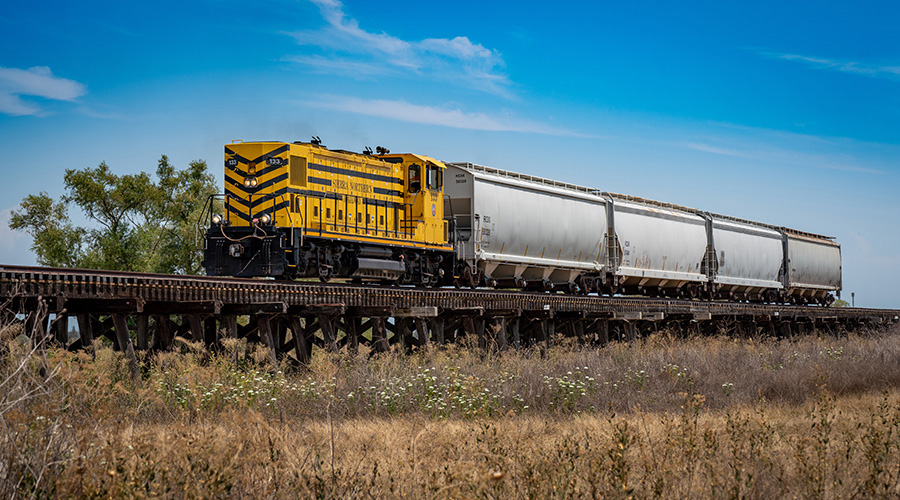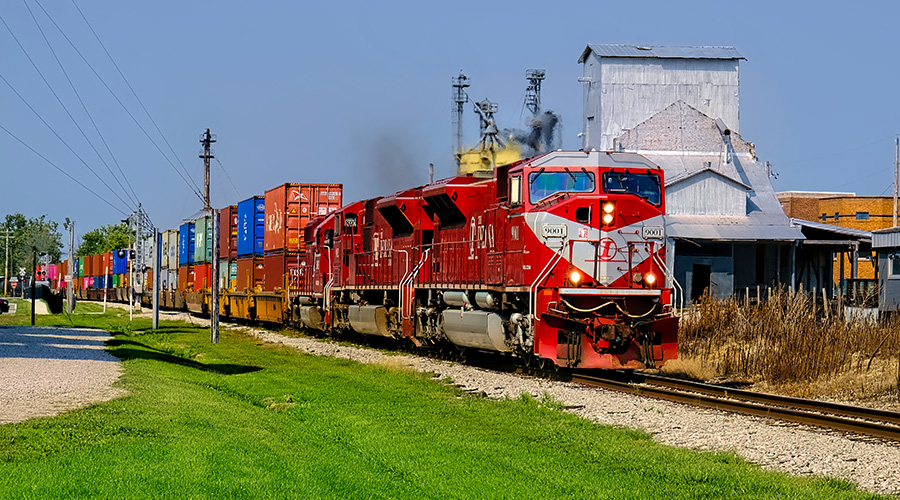Farmrail turns 40 as a pivotal farm-belt short line
11/15/2021
By Jeff Stagl, Managing Editor
Farmrail System Inc. reached a significant milestone on Oct. 19. The railroad marked its 40th anniversary as an essential short line in Oklahoma.
Since 1981, Farmrail has served as a lessee-operator for the Oklahoma Department of Transportation (ODOT). The short line was formed because the Chicago, Rock Island and Pacific Railroad went bankrupt in the late 1970s and left behind 1,200 miles in Oklahoma that became dormant.
The state then pioneered efforts to preserve rail service and access for shippers by purchasing portions of the track. That led to Farmrail’s birth — and later, its growth.
While the national railroad network contracted by 32%, the short line’s system eventually increased 580% from its initial 60-mile segment between Clinton and Elk City.
Farmrail’s network grew to 82 miles in 1982, then more than doubled in 2013 when the railroad purchased 89 miles of track from ODOT between Westhom and Elmer that had operated under a state lease for 20 years.
In 1987, Farmrail formed wholly owned affiliate Grainbelt Corp. to purchase 178 miles of track from Burlington Northern Railroad Co. to link Enid and Frederick.
Farmrail Chairman George Betke — who helped create the short line — has served the railroad throughout its first 40 years, starting as president. A former transportation analyst on Wall Street in the 1960s, he served as a consultant to short-line startups when railroad deregulation emerged after the Staggers Rail Act of 1980.
He had a hand in the formation of the Michigan Interstate Railway and Marquette Rail in Michigan, and Finger Lakes Railway Corp. in New York state. The Farmrail parent company retains a joint venture interest in Finger Lakes Railway.
In December 2013, Judy Petry was promoted from Farmrail’s controller to president and general manager, and then Betke assumed the role of chairman.
Now, the short line operates 347 miles of track in 12 Oklahoma counties. Between subsidiaries Farmrail Corp. and Grainbelt, the railroad moves wheat, feed grains, fertilizers, steel products, lumber, farm implements, gypsum rock. Two other commodities emerged as traffic generators more recently: cotton and oilfield/petroleum products.
 An undated photo shows a Farmrail train in the short line's early days. Farmrail System Inc.
An undated photo shows a Farmrail train in the short line's early days. Farmrail System Inc. The crude-oil boom
Farmrail’s volume growth peaked from 2016 to 2019 because crude-oil drilling activity ramped up in the nearby Andarko Basin, a 50,000-square-mile rich oil reserve covering parts of Oklahoma, Colorado, Kansas and Texas. Farmrail helped move unit trains of frac sand to the basin, as well as transport other inbound drilling equipment and outbound crude.
The emergence of oilfield traffic made Farmrail — once dependent on only one major commodity, agricultural products — into a “two-legged stool,” says Betke. The short line now relies on the health of the agricultural and oil markets.
But that health can be fleeting. Farmrail is reliant on good weather to ensure ag products traffic is strong, and dependent on the price of crude, oil demand and government policies to spur oilfield volume.
Negative developments in those oil market factors meant domestic crude production began to decline significantly two years ago. Farmrail hasn’t moved a unit train of frac sand to the Andarko Basin since the latter part of 2019, and overall annual volume has suffered as a result, says Betke.
“We have gone from one of our legs being up and down to extreme fluctuations in recent times,” he says. “Our traffic this year will only be 30% to 40% of our peak in 2018.”
Since Farmrail used temporary power and workers when traffic peaked, the short line didn’t need to slash its workforce when the oil spike ended, says Betke.
 The railroad moves various commodities, including farm equipment. But ag and petroleum products are the main revenue drivers. Farmrail System Inc.
The railroad moves various commodities, including farm equipment. But ag and petroleum products are the main revenue drivers. Farmrail System Inc. Cottoning to cotton
And at least a portion of the ag products market continues to show promise. Cotton traffic has evolved over the past 20 years and is growing in importance for the railroad.
A strain was created and planted in Oklahoma that could grow without as much moisture as cotton crops in the South. Now, cotton fields are taking over some acreage of wheat pastures in Oklahoma, which has become the nation’s third-largest cotton-producing state.
Altus, Oklahoma, has evolved into a logical gathering point for cotton seed and fiber because of its rail and highway access. A new loop road is being built around the city to alleviate truck traffic and permit the expansion of storage and loading facilities for shuttle-train export shipments to West Coast ports.
In addition, Plains Cotton Cooperative Association is expanding its Altus facility to originate unit trains for BNSF Railway Co. to carry to West Coast export terminals for Asian markets. The project includes a 55-car track for loading containerized cotton.
Farmrail will handle plant switching and the assembly of intermodal trains at the facility. The short line currently moves export cotton fiber with BNSF to West Coast ports, mostly to the Port of Long Beach, California, says Betke.
Over the past four decades, it’s been beneficial for Farmrail to have two connections with BNSF lines in Oklahoma, he says. Likewise, interchange points with the following three short lines have proven their worth: the Hollis & Eastern, Stillwater Central and Wichita, Tillman and Jackson railroads.
“We’re also fortunate to be in a state that wants to do business,” says Betke. “And we are in a centralized location in the U.S., so freight can go in any direction.”
 A newspaper article dated Nov. 19, 1981, from the Elk City Daily described Farmrail's launch. Farmrail System Inc.
A newspaper article dated Nov. 19, 1981, from the Elk City Daily described Farmrail's launch. Farmrail System Inc. Employees as stock owners
Betke is proud Farmrail in 1993 became what he claims was the first U.S. railroad to start a stock ownership plan for employees. Workers with one year of service can obtain shares. Now, a significant portion of the company is employee owned, says Betke.
“They can see the fruit in their labors and be invested in the performance of the company,” he says. “It’s a supplement to their railroad retirement.”
Stock ownership also has served as an incentive for employees to work together more tightly and build teamwork.
Farmrail will need that all-for-one acumen to increase traffic and revenue. Like all short lines, Farmrail has needed to hustle to generate more business, especially in hard times, says Betke.
The short line is trying to move more bonded cotton and attract more transloading business. Plus, finding more ways to generate non-operating revenue is vital going forward, Betke believes. Storing rail cars has helped in that regard.
“We have become a parking lot of sorts in the Midwest by storing parked rail cars,” he says. “We have stored up to 3,000 cars.”


